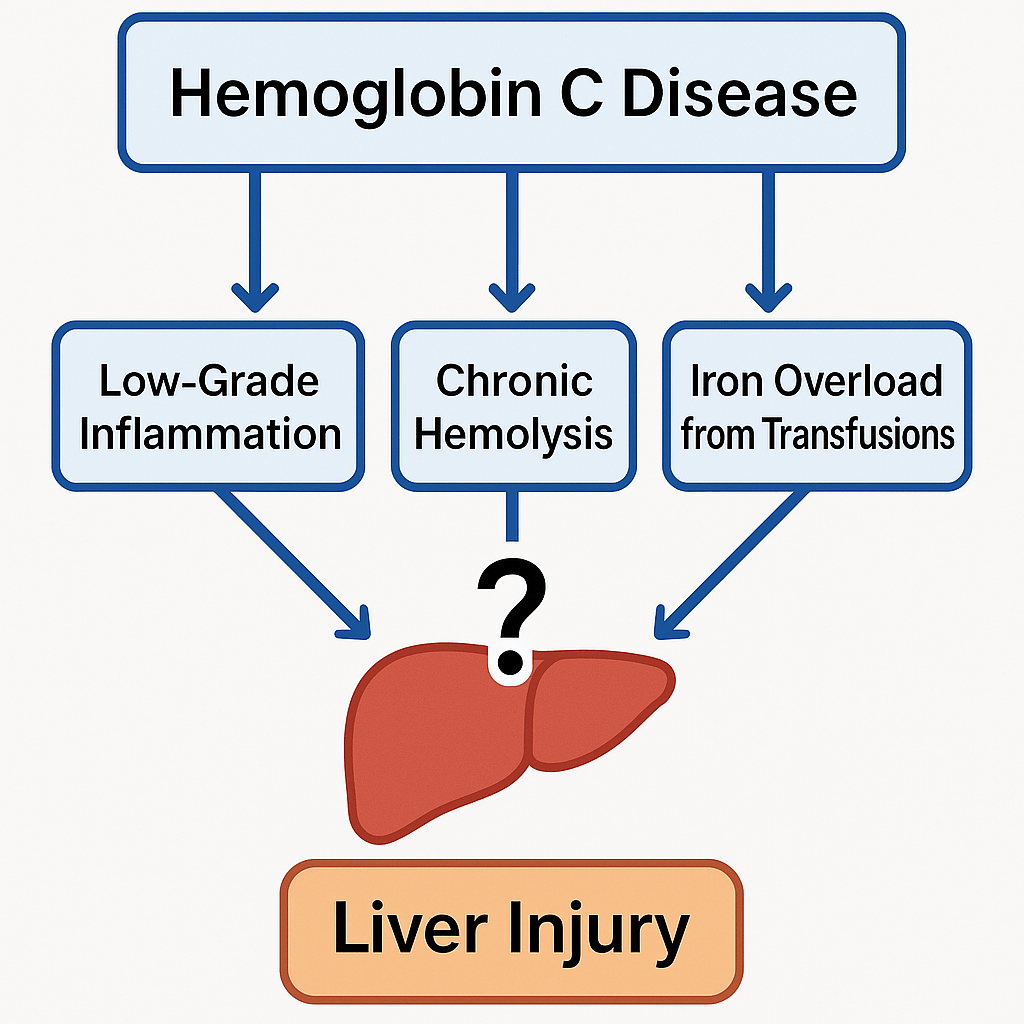Sunday Poster Session
Category: Liver
P1788 - Curious Case of Cirrhosis in a Hemoglobin C Host: Exploring a Possible Link to Lean Mash
Sunday, October 26, 2025
3:30 PM - 7:00 PM PDT
Location: Exhibit Hall

Wagmah Javed Khan, MD
St. Luke's Hospital
Chesterfield, MO
Presenting Author(s)
Wagmah Javed. Khan, MD1, Muhammad Arsalan, MD1, Hameed Ullah, MD1, Clifford Atuiri, MD1, Anas M. Hasic, MD2, Elie Chahla, MD1
1St. Luke's Hospital, Chesterfield, MO; 2Sarajevo School of Science & Technology, Saint Louis, MO
Introduction: Lean metabolic dysfunction-associated steatohepatitis (MASH) is seen in individuals with a normal body mass index (BMI < 25 kg/m²); a subtype of metabolic dysfunction-associated steatotic liver disease (MASLD). Thorough evaluation for alternate causes must be ruled out before attributing cirrhosis to lean MASH. Hemoglobin C disease is a rare hemoglobinopathy characterized by chronic hemolysis and systemic complications. Hemolytic anemias, such as thalassemia and sickle cell disease, have been implicated in secondary liver injury; however, Hemoglobin C disease has not been established as one of these potential causative factors. We present the first known case suggesting a possible link between Hemoglobin C disease and cirrhosis.
Case Description/
Methods: A 56-year-old male with a history of hemoglobin C disease presented with decompensated liver cirrhosis of unknown etiology with a clinical course including severe anemia, ascites, jaundice, and hepatic encephalopathy. A former diagnosis of liver disease was made outside of the U.S. 5 years prior, with no clear cause. Past medical history includes severe anemia requiring transfusions. His BMI was 22 kg/m², and he had no metabolic syndrome or significant alcohol use. He did not endorse the use of hepatotoxic medications, and workup was negative for hemochromatosis, Wilson's disease, alpha-1 antitrypsin deficiency, autoimmune hepatitis, and viral hepatitis. Features of hepatic cirrhosis, steatosis, and portal hypertension were seen on imaging. Endoscopy confirmed grade 3 esophageal varices, treated with band ligation. Blood and iron transfusions were initiated for severe anemia. In the absence of other identifiable causes, a diagnosis of lean MASH was considered.
Discussion: This case raises an important question about the potential role of hemoglobin C disease in chronic liver injury. Low-grade inflammation, chronic hemolysis, and iron overload from transfusions may create a hepatic environment susceptible to steatosis and fibrosis. Yet, hemoglobin C disease is excluded from current diagnostic frameworks for diagnosing lean MASH. In the absence of other etiologies and the rising interest in lean MASH, this case serves as an invitation to reconsider diagnostic paradigms and emphasize the need for further investigation into the hepatologic consequences of Hemoglobin C disease. Further studies are needed to determine whether Hemoglobin C disease should be considered in the differentials for cryptogenic cirrhosis in lean individuals.

Figure: Potential Contributors of Hemoglobin C Disease In Liver Injury
Disclosures:
Wagmah Khan indicated no relevant financial relationships.
Muhammad Arsalan indicated no relevant financial relationships.
Hameed Ullah indicated no relevant financial relationships.
Clifford Atuiri indicated no relevant financial relationships.
Anas Hasic indicated no relevant financial relationships.
Elie Chahla indicated no relevant financial relationships.
Wagmah Javed. Khan, MD1, Muhammad Arsalan, MD1, Hameed Ullah, MD1, Clifford Atuiri, MD1, Anas M. Hasic, MD2, Elie Chahla, MD1. P1788 - Curious Case of Cirrhosis in a Hemoglobin C Host: Exploring a Possible Link to Lean Mash, ACG 2025 Annual Scientific Meeting Abstracts. Phoenix, AZ: American College of Gastroenterology.
1St. Luke's Hospital, Chesterfield, MO; 2Sarajevo School of Science & Technology, Saint Louis, MO
Introduction: Lean metabolic dysfunction-associated steatohepatitis (MASH) is seen in individuals with a normal body mass index (BMI < 25 kg/m²); a subtype of metabolic dysfunction-associated steatotic liver disease (MASLD). Thorough evaluation for alternate causes must be ruled out before attributing cirrhosis to lean MASH. Hemoglobin C disease is a rare hemoglobinopathy characterized by chronic hemolysis and systemic complications. Hemolytic anemias, such as thalassemia and sickle cell disease, have been implicated in secondary liver injury; however, Hemoglobin C disease has not been established as one of these potential causative factors. We present the first known case suggesting a possible link between Hemoglobin C disease and cirrhosis.
Case Description/
Methods: A 56-year-old male with a history of hemoglobin C disease presented with decompensated liver cirrhosis of unknown etiology with a clinical course including severe anemia, ascites, jaundice, and hepatic encephalopathy. A former diagnosis of liver disease was made outside of the U.S. 5 years prior, with no clear cause. Past medical history includes severe anemia requiring transfusions. His BMI was 22 kg/m², and he had no metabolic syndrome or significant alcohol use. He did not endorse the use of hepatotoxic medications, and workup was negative for hemochromatosis, Wilson's disease, alpha-1 antitrypsin deficiency, autoimmune hepatitis, and viral hepatitis. Features of hepatic cirrhosis, steatosis, and portal hypertension were seen on imaging. Endoscopy confirmed grade 3 esophageal varices, treated with band ligation. Blood and iron transfusions were initiated for severe anemia. In the absence of other identifiable causes, a diagnosis of lean MASH was considered.
Discussion: This case raises an important question about the potential role of hemoglobin C disease in chronic liver injury. Low-grade inflammation, chronic hemolysis, and iron overload from transfusions may create a hepatic environment susceptible to steatosis and fibrosis. Yet, hemoglobin C disease is excluded from current diagnostic frameworks for diagnosing lean MASH. In the absence of other etiologies and the rising interest in lean MASH, this case serves as an invitation to reconsider diagnostic paradigms and emphasize the need for further investigation into the hepatologic consequences of Hemoglobin C disease. Further studies are needed to determine whether Hemoglobin C disease should be considered in the differentials for cryptogenic cirrhosis in lean individuals.

Figure: Potential Contributors of Hemoglobin C Disease In Liver Injury
Disclosures:
Wagmah Khan indicated no relevant financial relationships.
Muhammad Arsalan indicated no relevant financial relationships.
Hameed Ullah indicated no relevant financial relationships.
Clifford Atuiri indicated no relevant financial relationships.
Anas Hasic indicated no relevant financial relationships.
Elie Chahla indicated no relevant financial relationships.
Wagmah Javed. Khan, MD1, Muhammad Arsalan, MD1, Hameed Ullah, MD1, Clifford Atuiri, MD1, Anas M. Hasic, MD2, Elie Chahla, MD1. P1788 - Curious Case of Cirrhosis in a Hemoglobin C Host: Exploring a Possible Link to Lean Mash, ACG 2025 Annual Scientific Meeting Abstracts. Phoenix, AZ: American College of Gastroenterology.
